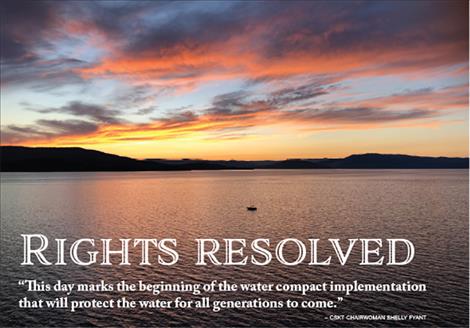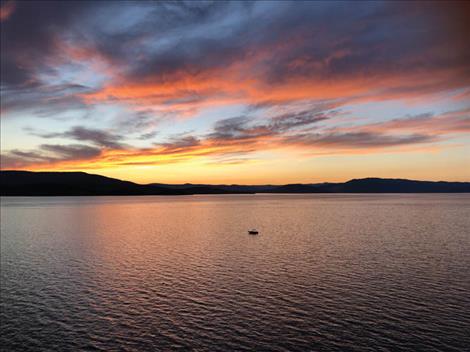CSKT Water Compact finalized by Secretary of Interior
Hey savvy news reader! Thanks for choosing local.
You are now reading
1 of 3 free articles.
Friday marked the end of a long and intricate journey to resolve water rights between the Confederated Salish and Kootenai Tribes, the state of Montana and the federal government.
That voyage came to an end when Secretary of Interior Deb Haaland signed the Confederated Salish and Kootenai-Montana Compact, which in turn formally sets in motion the Montana Water Rights Protection Act enacted by Congress on Dec. 21, 2020.
With the Secretary’s signature, the Tribes may now begin implementing the Compact and the companion Unitary Administration and Management Ordinance for the Flathead Reservation.
“Our elders continually remind us to protect our water and this day marks the beginning of the water compact implementation that will protect the water for all generations to come,” said CSKT Chairwoman Shelly Fyant. She also honored those who had worked to bring the settlement to completion, “especially those who are no longer with us … They were all instrumental in realizing this long-awaited vision.”
Although other water rights settlements have been reached between Montana tribes, the state’s Reserved Water Rights Compact Commission and the federal government, the settlement signed Friday was the most complex and far-reaching, due in large part to the expansive language of the 1855 Hellgate Treaty.
“Water is a sacred resource, and water rights are crucial to ensuring the health, safety and empowerment of Tribal communities,” said Secretary Haaland upon signing the document. “The department is committed to upholding our trust responsibilities and delivering long-promised water resources to Tribes, certainty to all their non-Indian neighbors, and a solid foundation for future economic development for entire communities dependent on common water resources.”
The compact and settlement act quantify the Tribes’ water rights and authorize $1.9 billion in funding for a variety of purposes, including improving the water efficiency of the federal Flathead Indian Irrigation Project, originally constructed in the early 1900s.
According to a Bureau of Reclamation report written in 2001, the sprawling project delivers irrigation water to 127,000 acres, and includes 15 reservoirs and dams, over 1,300 miles of canal and lateral ditches, and more than 10,000 minor structures. Serving as “an important economic driver for the Reservation and the state of Montana,” the Department of Interior asserts that it “has long been overdue for rehabilitation.”
Settlement funds may also be used by the Tribes to restore and protect tribal resources, and construct and maintain community water distribution and wastewater facilities.
A press release from the Tribes notes that the secretary’s signature Friday triggers “notable changes in how water rights within the Flathead Reservation are governed.”
Among those:
• The establishment of the five-member Flathead Reservation Water Management Board to administer all aspects of water use within the reservation. The governor will appoint two members to the board, the Tribes will appoint two, and those four members will select a fifth.
• The water board will have the authority to hire a water engineer to carry out the functions assigned by the board in accordance with the new Unitary Administration and Management Ordinance. That ordinance governs all water rights within the reservation, including permitting of new uses, changes of existing uses and enforcement.
According to the statement, the Tribes, tribal members and their allottees have five years to register existing uses of the Tribal Water Right that were not quantified in the compact, and may seek assistance from the CSKT Natural Resources Department in filing those documents.
Non-tribal members who want to file an existing use under state law, such as groundwater development for domestic and stock water purposes, have 180 days to do so, and make seek assistance from the Montana Department of Natural Resources and Conservation until the Water Board is fully operational.
Tribal members have the option of registering a qualifying existing use as part of the Tribal Water Right or as a state-law-based water right.
Lt. Gov. Kristen Juras reached out to commissioners in Lake and Sanders counties last week, seeking candidates for the Water Management Board. The local commission plans to meet Tuesday morning at 10 a.m. with Sanders County Commissioner Glen Magera to discuss that process.
The implications of the historic settlement have already been a somewhat contentious subject between irrigators and county government. In early September, commissioners tabled a resolution to cease collecting fees for irrigation districts in 2022 after irrigators complained that the move was premature. On Tuesday, the commissioners are scheduled to amend a resolution they passed last week to quit spending county funds “to repair, replace or rehabilitate the infrastructure of the Flathead Indian Irrigation Project.”
The agreement signed Friday was originally passed by the Montana Legislature and signed by the governor in 2015. Five years later, the U.S. Congress passed the Montana Water Rights Protection Act, which also transferred ownership of the National Bison Range to the Tribes. That act was signed into law by the president six days later. Haaland’s signature marked the final step in the approval process.
Proponents say the settlement promises an end to decades of litigation. According to the Department of Interior’s press release, it offers “an opportunity for a new era of improved relationships among the Tribes, the state, and irrigator communities through a unique and carefully crafted framework that will clarify existing uses, allow for the establishment of new uses on the Reservation, and protect important fish and wildlife habitat in the region.”
Gov. Gianforte echoes that position. In a statement Friday, he said “farmers, ranchers, the Confederated Salish and Kootenai Tribes, and all Montana water users will have the certainty they need about the use of one of our most precious resources, water.”

















